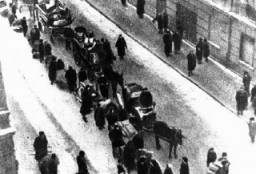You searched for: holocaust
<< Previous | Displaying results 801-825 of 1164 for "holocaust" | Next >>
-
Hans Vogel's Diary
Media EssayDiaries reveal some of the most intimate, heart-wrenching accounts of the Holocaust. They record in real time the feelings of loss, fear, and, sometimes, hope of those facing extraordinary peril. Hans Vogel kept a diary journaling his family's fli...

-
Helene Reik's diary
Media EssayDiaries reveal some of the most intimate, heart-wrenching accounts of the Holocaust. They record in real time the feelings of loss, fear, and, sometimes, hope of those facing extraordinary peril. Written on postcard...
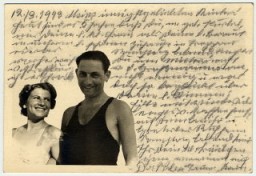
-
Salonika - Photograph
Media EssayBefore World War II, Salonika had the largest Jewish community in Greece. In April 1941, Germany occupied parts of Greece, including Salonika. Between 1941 and 1943, Salonika's Jewish community was destroyed. More t...
-
Mechelen - Maps
Media EssayIn the summer of 1942, the Germans made preparations to deport the Jews of Belgium. They converted military barracks in the city of Mechelen into a transit camp. Between August 4, 1942, and July 31, 1944, a total of 28 trains carrying 25,257 Jews left Mechelen for German-occupied Poland; most of them went to Auschwitz-Birkenau. This figure represented more than half of the Belgian Jews murdered during the Holocaust.
-
Antisemitism (Abridged Article) - Photograph
Media EssayThe word antisemitism means prejudice against or hatred of Jews. The Holocaust is history’s most extreme example of antisemitism.The Nazi Party spread antisemitic propag...
-
Receiving tattoos at Auschwitz
Media EssayThe Auschwitz camp complex was the only location that issued identifying tattoos during the Holocaust. Only prisoners selected for forced labor were assigned serial numbers. Prisoners who were sent directly to the gas chambers were not registered or...
-
Tattoos and Numbers: The System of Identifying Prisoners at Auschwitz - ID Card/Oral History
Media EssayThe Auschwitz camp complex was the only location that issued identifying tattoos during the Holocaust. Only prisoners selected for forced labor were assigned serial numbers. Prisoners who were sent directly to the gas chambers were not registered...
-
Carl Clauberg: Photographs
Media EssayCarl Clauberg was a German research gynecologist. During the Holocaust, he conducted medical experiments on the female prisoners at Auschwitz. His mass sterilization experiments caused severe pain and sometimes death. Clauberg also experimented on w...
-
Courtroom Sketch of Elie Wiesel at the Trial of Klaus Barbie
ArtifactCourtroom sketch by artist David Rose of Nobel laureate and Holocaust survivor Elie Wiesel on the witness stand at the trial of Klaus Barbie. During his testimony, Wiesel stated that "The killer kills twice. First, by killing, and then by trying to wipe out the traces." June 2, 1987.
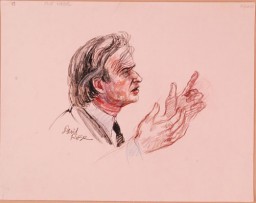
-
Krakow ghetto armband
ArtifactIn December 1939, German authorities required Jews residing in the Generalgouvernement (which included Krakow) to wear white armbands with blue Stars of David for purposes of identification. The armband pictured here was donated to the United States Holocaust Memorial Museum in 2001 by Akiva Kohane.
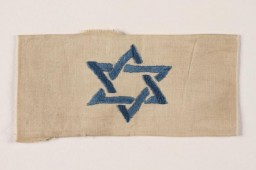
-
Julian Noga's prisoner uniform jacket
ArtifactA blue and gray striped jacket from the Flossenbürg concentration camp. The letter "P" on the left front of the jacket indicates that it was worn by a Polish, non-Jewish prisoner. "P" stands for "Pole" in German. The jacket was donated to the United States Holocaust Memorial Museum by the prisoner who wore it, Julian Noga.
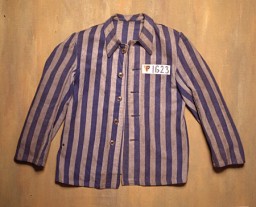
-
Casting of Majdanek gas chamber door
ArtifactThis casting of a gas chamber door in the Majdanek camp, near Lublin, Poland, was commissioned by the United States Holocaust Memorial Museum. Each gas chamber in Majdanek was fitted with an airtight metal door and was bolted shut before gas entered the chamber inside. SS guards could observe the killing process through peepholes in the upper center of the door.
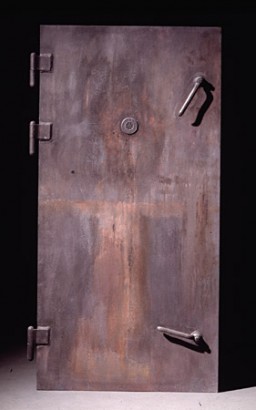
-
Pages of Hebrew prayer books damaged during Kristallnacht
ArtifactThe pages photographed here are from Hebrew prayer books destroyed during the Kristallnacht ("Night of Broken Glass") pogrom of November 9 and 10, 1938. These pages were damaged by fire during the destruction of the synagogue in Bobenhausen, Germany. The Jewish community of Giessen donated them to the United States Holocaust Memorial Museum in 1989.
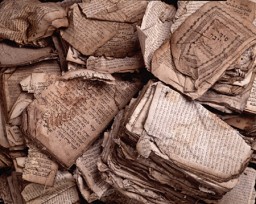
-
The Nazi Olympics: Introduction
FilmIn this video introduction to The Nazi Olympics: Berlin 1936, American Jewish athlete Marty Glickman, US Holocaust Memorial Museum Director Sara J. Bloomfield, exhibition curator Susan Bachrach, and German Jewish athlete Gretel Bergmann reflect and remember the 1936 Olympic Games as more than history.
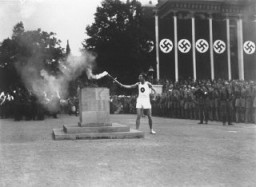
-
Sophie Turner-Zaretsky, Mark Polansky, and Bill Parsons with "Refugee" the bear
PhotoDr. Sophie Turner-Zaretsky, Space Shuttle Discovery Commander Mark Polansky, and United States Holocaust Memorial Museum chief of staff Bill Parsons. They are holding a replica of "Refugee" bear and a photo of a Darfurian child refugee, items taken by Commander Polansky on a December 2006 Space Shuttle mission.

-
'A Dangerous Lie: The Protocols of the Elders of Zion' exhibition
PhotoPanel from the exhibition A Dangerous Lie: The Protocols of the Elders of Zion which was on display at the United States Holocaust Memorial Museum from 2006–18. The exhibition explored the continuing impact of the most widely distributed antisemitic publication of modern times.
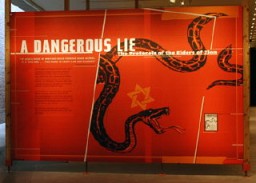
-
Luggage belonging to Jews who were deported to killing centers
PhotoA collection of valises belonging to Jews who were deported to killing centers. These valises are displayed at the base of the railcar on the third floor of the Permanent Exhibition at the United States Holocaust Memorial Museum. Washington, DC, 1993–1995.
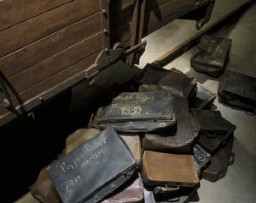
-
Oskar Schindler next to the tree planted in his honor
PhotoAt Yad Vashem, the Israeli national institution of Holocaust commemoration, Oskar Schindler stands next to the tree planted in honor of his rescue efforts. Jerusalem, Israel, 1970.

-
Jewish refugees on the Exodus 1947 ship
PhotoBritish police stand among Jewish refugees on the decks of the refugee ship Exodus 1947 at Haifa port. British forces returned the refugees to displaced persons camps in Germany, dramatizing the plight of Holocaust survivors attempting to enter Palestine. July 19, 1947.
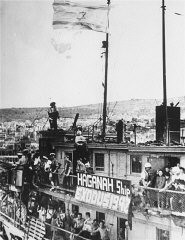
-
Passengers on the refugee ship Exodus 1947
PhotoPassengers on the deck of the refugee ship Exodus 1947 in Haifa. British forces returned them to displaced persons camps in Germany, dramatizing the plight of Holocaust survivors attempting to enter Palestine. Haifa, Palestine, July 18, 1947.
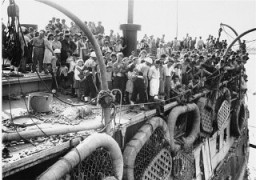
-
Abraham Lewenson testifies
PhotoAbraham Lewenson testifying at the trial of Adolf Eichmann. Jerusalem, Israel, June 2, 1961. The Eichmann trial created international interest, bringing Nazi atrocities to the forefront of world news. Testimonies of Holocaust survivors generated interest in Jewish resistance. The trial prompted a new openness in Israel as the country confronted this traumatic chapter.
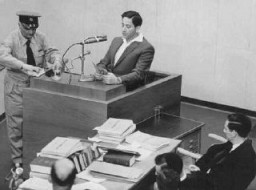
-
Coffins containing bodies of Jews killed in the Kielce pogrom
PhotoCoffins containing bodies of Jews killed in the Kielce pogrom. Poland, July 6, 1946. The mass violence of the Kielce pogrom drew on an entrenched local history of antisemitism–especially false allegations accusing Jews of using the blood of Christian children for ritual purposes (a charge known as a “blood libel”)–with the intent of discouraging the return of Jewish Holocaust survivors to Poland.
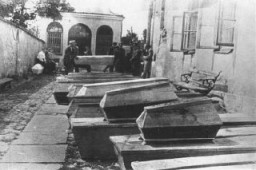
-
Armenian children lie in the street of an unidentified town
PhotoArmenian children lie in the street of an unidentified town. Photograph taken by Armin T. Wegner. Wegner served as a nurse with the German Sanitary Corps. In 1915 and 1916, Wegner traveled throughout the Ottoman Empire and documented atrocities carried out against the Armenians. [Courtesy of Sybil Stevens (daughter of Armin T. Wegner). Wegner Collection, Deutsches Literaturarchiv, Marbach & United States Holocaust Memorial Museum.]
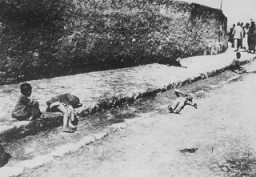
-
Armenian families in a refugee camp
PhotoArmenian families next to makeshift tents in a refugee camp. Ottoman Empire, 1915-16.Photograph taken by Armin T. Wegner. Wegner served as a nurse with the German Sanitary Corps. In 1915 and 1916, Wegner traveled throughout the Ottoman Empire and documented atrocities carried out against the Armenians. [Courtesy of Sybil Stevens (daughter of Armin T. Wegner). Wegner Collection, Deutsches Literaturarchiv, Marbach & United States Holocaust Memorial Museum.]

-
Jews forced to move into the Lodz ghetto
PhotoJews forced to move into the Lodz ghetto. Lodz, Poland, date uncertain. During the Holocaust, the creation of ghettos was a key step in the Nazi process of brutally separating, persecuting, and ultimately destroying Europe's Jews. Ghettos were often enclosed districts that isolated Jews from the non-Jewish population and from other Jewish communities.
